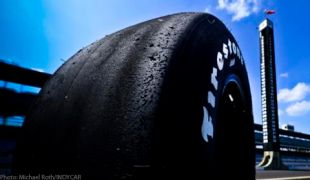From one challenge to the next, Firestone steadfastly rolls on
IndyCar, IndyCar commentary — By Steph Wallcraft on March 25, 2014 6:53 amNow seems like an especially good time to discuss how great a partner Firestone has been to the Verizon IndyCar Series over the years.
Most notably and importantly, NASCAR is currently reeling from a high number of tire failures under race conditions and the effect it had on the outcome of its race at Auto Club Speedway this past weekend.
Meanwhile, the staff here at More Front Wing spent some time trying to determine when the last time was that a Firestone Firehawk failed under load on an IndyCar, and we couldn’t come up with a definitive answer.
So, we went to IndyCar and asked them. They couldn’t remember the last time it happened, either.
Race car drivers don’t want anything to fail on their cars, especially not at speed, but a sudden tire failure would land near the very bottom of the list of preferences. In open-wheel in particular, the results are highly unpredictable and often catastrophic. That’s why there was a massive push to retain Firestone as IndyCar’s tire partner a couple of years ago when the threat of change emerged.
The decision has paid off as Firestone appears to be as committed to IndyCar racing as ever.
This year marks the 10th running of the Grand Prix of St. Petersburg, and the inaugural running marked the first time that Firestone produced a road or street course tire for what was then the Indy Racing League. As the anniversary approaches, Bridgestone Americas Motorsports Chief Engineer and Manager of Race Tire Development Dale Harrigle – who is celebrating an anniversary himself as he enters his 20th year working with Firestone and IndyCar – recalls the initial challenges that development presented on all sides.
“It was actually quite a big transition,” Harrigle recalls. “The Indy Racing League at that time was fully dedicated to ovals, so the cars were optimized for ovals. The weight distribution and many of the things on the cars were specific to oval racing. Of course, IndyCar changed all of the parts and pieces that they could, but there were still elements of the car that were dedicated to ovals that meant that our road and street course tires for those first couple of seasons were a little bit compromised compared to where we are now.
“Now, the IndyCar is a true purpose-built machine for all of the different types of circuits, and it has allowed us to make a few changes to our road and street course tires to really get the true, optimal performance out of them.”
Firestone has sometimes been criticized for not taking a path similar to that of Pirelli in Formula 1 and having its alternate tires on road and street courses fall off significantly through a stint to add drama to the racing. However, this is a conscious decision that Firestone, IndyCar, and the drivers and teams are in agreement with. Where quality and safety are concerned, no one is willing to make compromises.
“We’re constantly working with IndyCar and also the teams and the drivers to try to get their opinions of how the primaries and alternates perform, what that gap looks like, what we think the ideal gap would be,” Harrigle says. “We had IndyCar into our technical center at Firestone last November to review all of the racing from the 2013 season and make some tweaks and some plans for 2014.
“We’re actually pretty happy right now with the gap between the Firestone primary and alternate tires. We thought last year we saw some pretty good racing. We saw the alternates go off as they’re designed to do. Right now for 2014, I think you’ll see the primary and alternate gaps stay about the same as it was last year.”
NEXT PAGE: Director of Motorsports Lisa Boggs reflects on partnership and the value of St. Petersburg
Pages: 1 2









[…] From one challenge to the next, Firestone steadfastly rolls on […]